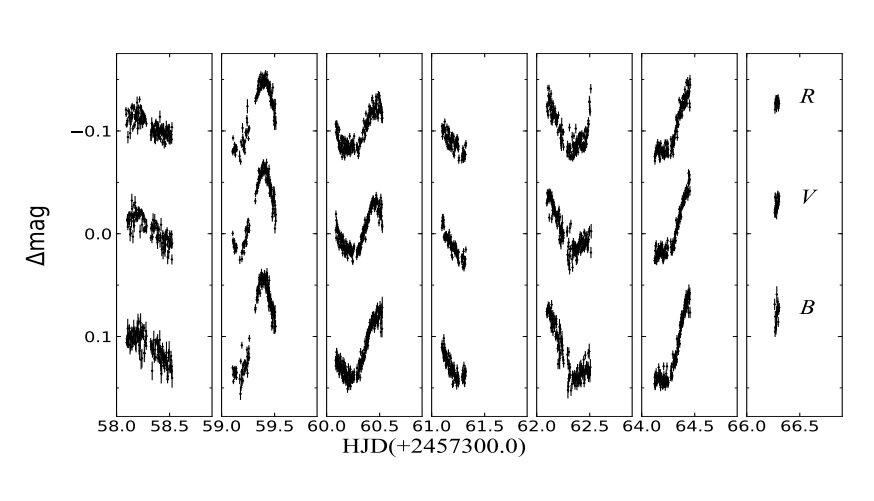From Chinese Academy of Sciences
via
September 21, 2020
Tomasz Nowakowski

Light curves of the newly detected variable star, designated V23, in R, V and B bands. Credit: Li et al., 2020.
Chinese astronomers have conducted a study of variable stars in the galactic open cluster NGC 1912 and its surrounding field, detecting 11 new variables in this cluster, including binary systems. The study was detailed in a research paper published September 11 on the arXiv pre-print repository, Investigating Variable Stars in the Open Cluster NGC 1912 and Its Surrounding Field.
Star clusters offer excellent opportunities to study stellar evolution, as they are collections of stars with similar properties, for instance age, distance and initial composition. In particular, astronomers often search for variable stars in young clusters, which could be crucial in advancing the understanding of pre-main-sequence (PMS) stars, and therefore the initial phases of stellar evolution.
Estimated to be about 300 million years old, NGC 1912 (also known as Messier 38) is an open cluster located some 3,200 light years away, in the anti-center direction of our Milky Way galaxy. So far, over 800 member stars of this cluster have been identified, which includes at least 20 variables of different types such as Delta Scuti, Gamma Doradus, and also eclipsing binaries (EBs).
Now, a team of astronomers led by Chunyan Li of the Chinese Academy of Sciences (CAS) reports the discovery of 11 new variable stars in NGC 1912 based on observations performed with the Nanshan 1-m telescope (NOWT) of the Xinjiang Astronomical Observatory.

Nanshan 1-m telescope (NOWT). Xinjiang Astronomical Observatory
To confirm the membership of the newly found objects, they used the Unsupervised Photometric Membership Assignment in Stellar Clusters (UPMASK) method and data from ESA’s Gaia satellite.
“We investigated and characterized the variable stars in the open cluster NGC 1912 and its surrounding field by photometric observations,” the astronomers wrote in the paper.
Out of the 11 newly detected variables, six are Gamma Doradus stars, one is a Delta Scuti star, three are detached binaries and one was classified as a contact binary. Additionally, the study also detected 13 previously known variable stars in NGC 1912.
The newfound variables have mean instrumental magnitudes in the V band ranging from 15.0 to 18.62 mag, and amplitudes of folded light curves in V band between 0.01 and 1.5. The periods of these stars were measured to be within the range of 0.11 to 2.56 days.
One of the newfound variables, a Gamma Doradus star designated V4, was confirmed to be the member of NGC 1912. The cluster membership probability of two other Gamma Doradus stars, V3 and V5, was estimated to be 50 and 80 percent. The membership of the remaining eight variables is still highly uncertain.
The astronomers added that further studies are needed to uncover more insights into the properties of the newly detected variables and to finally confirm their cluster membership. In particular, more data from NASA’s Transiting Exoplanet Survey Satellite (TESS) could help us better understand the nature of variable stars in NGC 1912.
See the full article here .
five-ways-keep-your-child-safe-school-shootings
Please help promote STEM in your local schools.
The Chinese Academy of Sciences is the linchpin of China’s drive to explore and harness high technology and the natural sciences for the benefit of China and the world. Comprising a comprehensive research and development network, a merit-based learned society and a system of higher education, CAS brings together scientists and engineers from China and around the world to address both theoretical and applied problems using world-class scientific and management approaches.
Since its founding, CAS has fulfilled multiple roles — as a national team and a locomotive driving national technological innovation, a pioneer in supporting nationwide S&T development, a think tank delivering S&T advice and a community for training young S&T talent.
Now, as it responds to a nationwide call to put innovation at the heart of China’s development, CAS has further defined its development strategy by emphasizing greater reliance on democratic management, openness and talent in the promotion of innovative research. With the adoption of its Innovation 2020 programme in 2011, the academy has committed to delivering breakthrough science and technology, higher caliber talent and superior scientific advice. As part of the programme, CAS has also requested that each of its institutes define its “strategic niche” — based on an overall analysis of the scientific progress and trends in their own fields both in China and abroad — in order to deploy resources more efficiently and innovate more collectively.
As it builds on its proud record, CAS aims for a bright future as one of the world’s top S&T research and development organizations.



